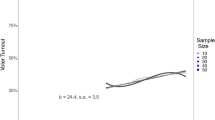Abstract
It has been suggested that voting may be an ``expressive''action taken without regard to any hope of actuallyinfluencing election outcomes on the margin. However, therehas been no real-world evidence brought to bear on thequestion of whether the propensity of an individual to voteand the propensity of that same individual to engage in otherforms of ``expressive'' behavior are correlated in anystatistically meaningful sense. Drawing from longitudinal datafound in the National Election Surveys we report compellingevidence of a strong, positive relationship between what weterm ``political expressiveness'' and the act of voting.
Similar content being viewed by others
References
Aldrich, J.H. (1993). Rational choice and turn-out. American Journal of Political Science 37: 246–278.
Ashenfelter, O. and Kelley, S., Jr. (1975). Determinants of participation in congressional elections. Journal of Law and Economics 18: 695–733.
Bernstein, R.A. and Packard, E. (1997). Paths to participation in electoral politics: The importance of mobilization. Mimeo. Paper presented at the American Political Science Association meetings in Washington, DC, August.
Brennan, H.G. and Lomasky, L.E. (1993). Democracy and decision. Cambridge: Cambridge University Press.
Campbell, A., Converse, P.E., Miller, W.E. and Stokes, D.E. (1960). The American voter. New York: Wiley.
Conway, M.M. (1991). Political participation in the United States. Washington, DC: Congressional Quarterly Inc.
Cox, W.M. and Alm, R. (1997). Time well spent. Federal Reserve Bank of Dallas, Annual Report.
Fischer, A.J. (1996). A further experimental study of expressive voting. Public Choice 88: 171–184.
Foster, C.B. (1984). The performance of rational voter models in recent presidential elections. American Political Science Review 78: 678–690.
Matsusaka, J.G. and Palda, F. (1999). Voter turnout: How much can we explain? Public Choice 98: 431–446.
Rosenstone, S.J. and Hansen, J.M. (1993). Mobilization, participation, and democracy in America. New York: Macmillan.
Shachar, R. and Nalebuff, B. (1999). Follow the leader: Theory and evidence on political participation. American Economic Review 89: 525–547.
Teixeira, R.A. (1987). Why Americans don't vote: Turnout decline in the United States 1960-1984. New York: Greenwood Press.
Wolfinger, R.E. and Rosenstone, S.J. (1980). Who votes? New Haven: Yale University Press.
Author information
Authors and Affiliations
Rights and permissions
About this article
Cite this article
Copeland, C., Laband, D.N. Expressiveness and Voting. Public Choice 110, 351–363 (2002). https://doi.org/10.1023/A:1013093610591
Issue Date:
DOI: https://doi.org/10.1023/A:1013093610591




